seats AUDI S6 2015 Owner's Manual
[x] Cancel search | Manufacturer: AUDI, Model Year: 2015, Model line: S6, Model: AUDI S6 2015Pages: 314, PDF Size: 77.57 MB
Page 138 of 314
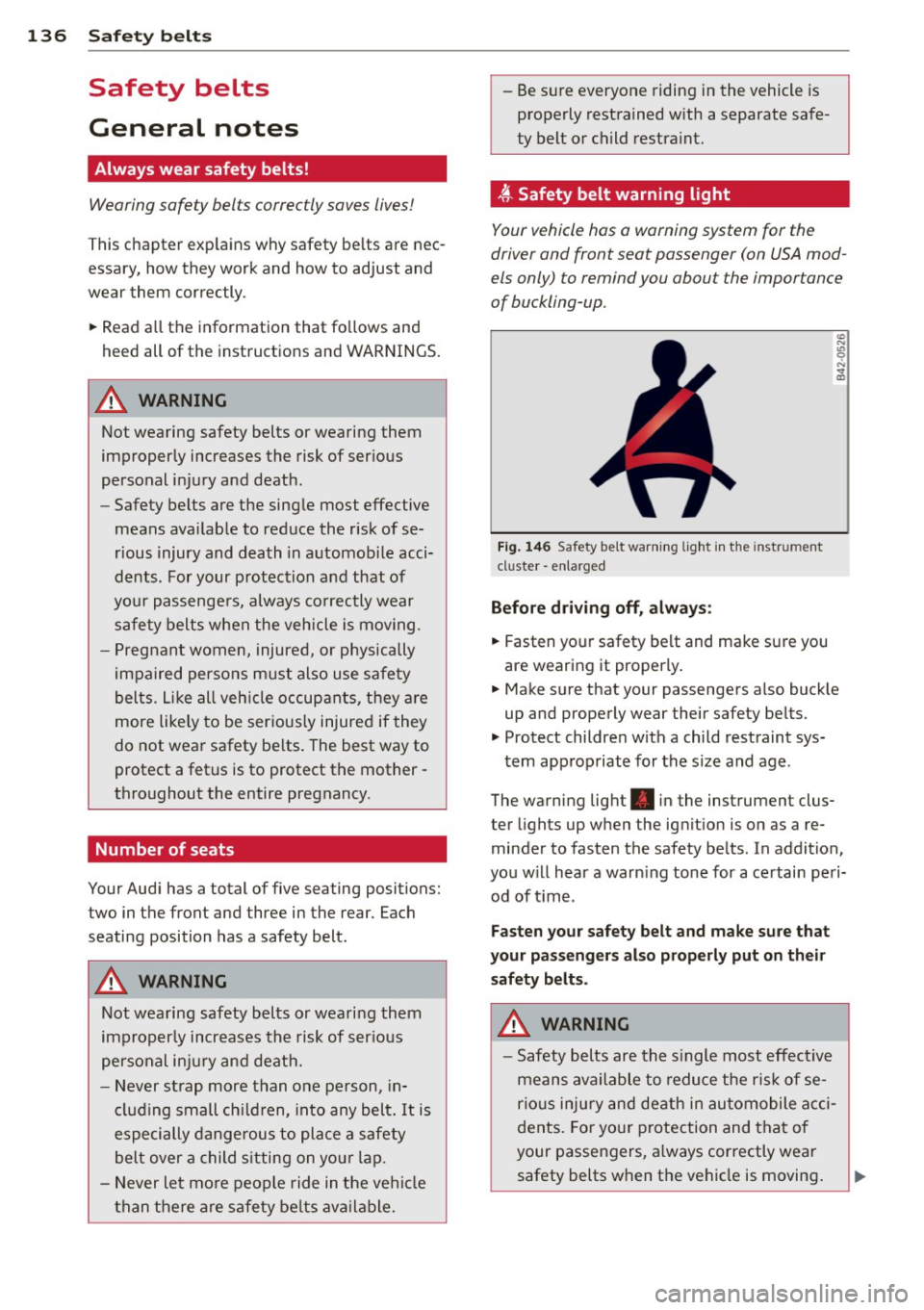
136 Safety belts
Safety belts
General notes
Always wear safety belts!
Wearing safety belts correctly saves lives!
This chapter explains why safety be lts are nec
essary, how they work and how to adjust and
wear them correctly .
.. Read a ll the information that fo llows and
heed all of the instructions and WARNINGS.
A WARNING
Not wearing safety belts or wearing them
improperly increases the risk of ser ious
personal in jury and death .
- Safety belts are the sing le most effective
means avai lab le to reduce the risk of se
r ious injury and dea th in a utomob ile acci
dents. For your protection and that of
yo ur passenge rs, always co rrectly wear
safety belts when the vehicle is moving.
- Pregnant women, injured, or physically
im paired perso ns m ust also use safety
belts. Lik e all veh icle occup ants, they are
more like ly to be ser iously injured if they
do not wea r safety be lts . The best way to
protect a fetus is to protect the mother -
throughout the entire pregnancy.
Number of seats
Your Audi has a total of five seating positions: two in the front and three in the rear. Each
seating position has a safety belt.
A WARNING
Not wea ring safety belts or weari ng them
improp erly increases the risk of ser ious
pe rsonal i njury and deat h.
- Never st rap more than one pe rson, in
cl uding small ch ild ren, into any belt.
It is
e speci ally dange rous to pla ce a safety
belt over a child s itting on yo ur lap.
- N ever le t mo re people ride in the ve hicl e
than there are s afe ty be lts avail able. -
Be s ure everyone riding in the vehicle is
properly restrained w ith a separate safe
ty belt or child restra int.
t Safety belt warning light
Your vehicle hos o warning system for the
driver and front seat passenger (on USA mod
els only) to remind you about the importance
of buckling-up .
Fi g. 146 Safety belt warni ng light in the instrument
cluster -en larged
Before driv ing off, alway s:
.. Fasten yo ur safety belt and make su re you
are wearing it properly .
.. Make s ure that your passengers also buck le
up and properly wear their safety be lts.
.. Protect childre n w ith a child restraint sys-
tem app ropriate for the s ize and age.
The warn ing light . in the instrument clus
ter lights up when the ign ition is on as a re
minder to fasten the safety be lts. In addition,
you w ill hear a warn ing tone for a ce rtai n pe ri
od of t ime.
Fasten you r safety belt and make sure that
your pass eng ers also properly put on the ir
s afety belt s.
A WARNING .....=-
-Safety b elts are the s ingle most eff ect ive
means avai lable to reduce t he ri sk of se
rio us inju ry and de ath in au tomobile acci
dents. Fo r you r protection and that of
your passengers, a lways cor rectly wear
safety belts when t he vehicle is moving .
Page 140 of 314
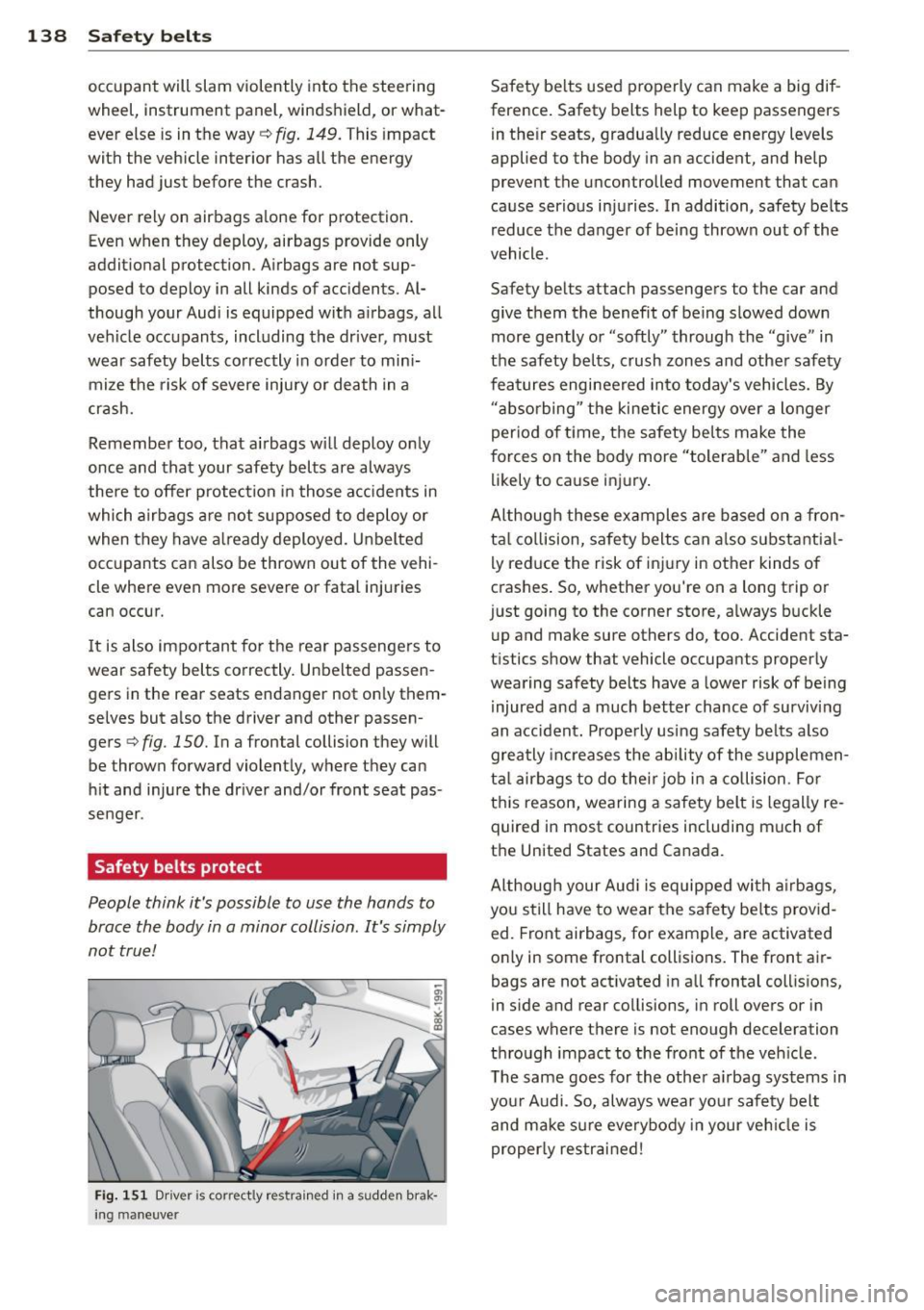
138 Safety belts
occupant will slam violently into the steering
wheel, instrument panel, windshield, or what
ever else is in the way
c::> fig. 149. This impact
with the vehicle interior has all the energy
t hey had just before the crash.
Never rely on a irbags alone for protection.
Even when they deploy, airbags provide only
additional protection. Airbags are not sup
posed to deploy in all kinds of accidents. Al
though your Audi is equipped with airbags, all
vehicle occupants, including the driver , must
wear safety belts correctly in order to mini
mize the risk of severe injury or death in a
crash.
Remember too, that airbags will deploy only
once and that your safety belts are always
there to offer protection in those accidents in
which airbags are not supposed to deploy or
when they have already deployed . Unbelted
occupants can also be thrown out of the vehi
cle where even more severe or fatal injuries
can occur.
It is also important for the rear passengers to
wear safety belts correctly. Unbelted passen
gers in the rear seats endanger not only them
selves but also the driver and othe r passen
gers ~
fig. 150. In a frontal collision they will
be thrown forward violently, where they can
hit and injure the driver and/or front seat pas
senger .
Safety belts protect
People think it's possible to use the hands to
brace the body in a minor collision . It's simply
not true !
Fig. 151 Driver is co rr ect ly re strain ed in a sudd en brak
ing maneuve r
Safety belts used properly can make a big dif
ference. Safety belts help to keep passengers
in their seats, gradually reduce energy levels
applied to the body in an accident, and help
prevent the uncontrolled movement tha t can
cause serious injuries . In addition, safety belts
reduce the danger of being thrown out of the
vehicle .
Safety belts attach passengers to the car and
give them the benefit of being slowed down
more gently or "softly" through the "give" in
the safety belts, crush zones and other safety
features engineered into today's vehicles. By
"absorbing " the kinetic energy over a longer
period of ti me, the safety belts make the
forces on the body more "tolerable" and less
likely to cause injury.
Although these examples are based on a fron
tal collision, safety belts can also substantial
ly reduce the r isk of injury in other kinds of
crashes. So, whether you're on a long trip or
just going to the corner store, always buckle up and make sure others do, too. Accident sta
tistics show that vehicle occupants properly
wearing safety belts have a lower risk of being
injured and a much better chance of surviving
an accident. Properly using safety belts also
greatly increases the ability of the supplemen
tal airbags to do their job in a collision . For
this reason, wearing a safety belt is legally re
quired in most countries including much of
the United States and Canada.
Although your Audi is equipped with airbags,
you still have to wear the safety belts provid
ed. Front airbags , for example, are activated
only in some frontal collisions. The front air
bags are not activated in all frontal collisions,
in side and rear collisions, in roll overs or in
cases where there is no t enough decelera tion
through impact to the front of the vehicle .
The same goes for the other airbag systems in
your Audi . So, always wear your safety belt
and make sure everybody in your vehicle is
properly restrained!
Page 144 of 314
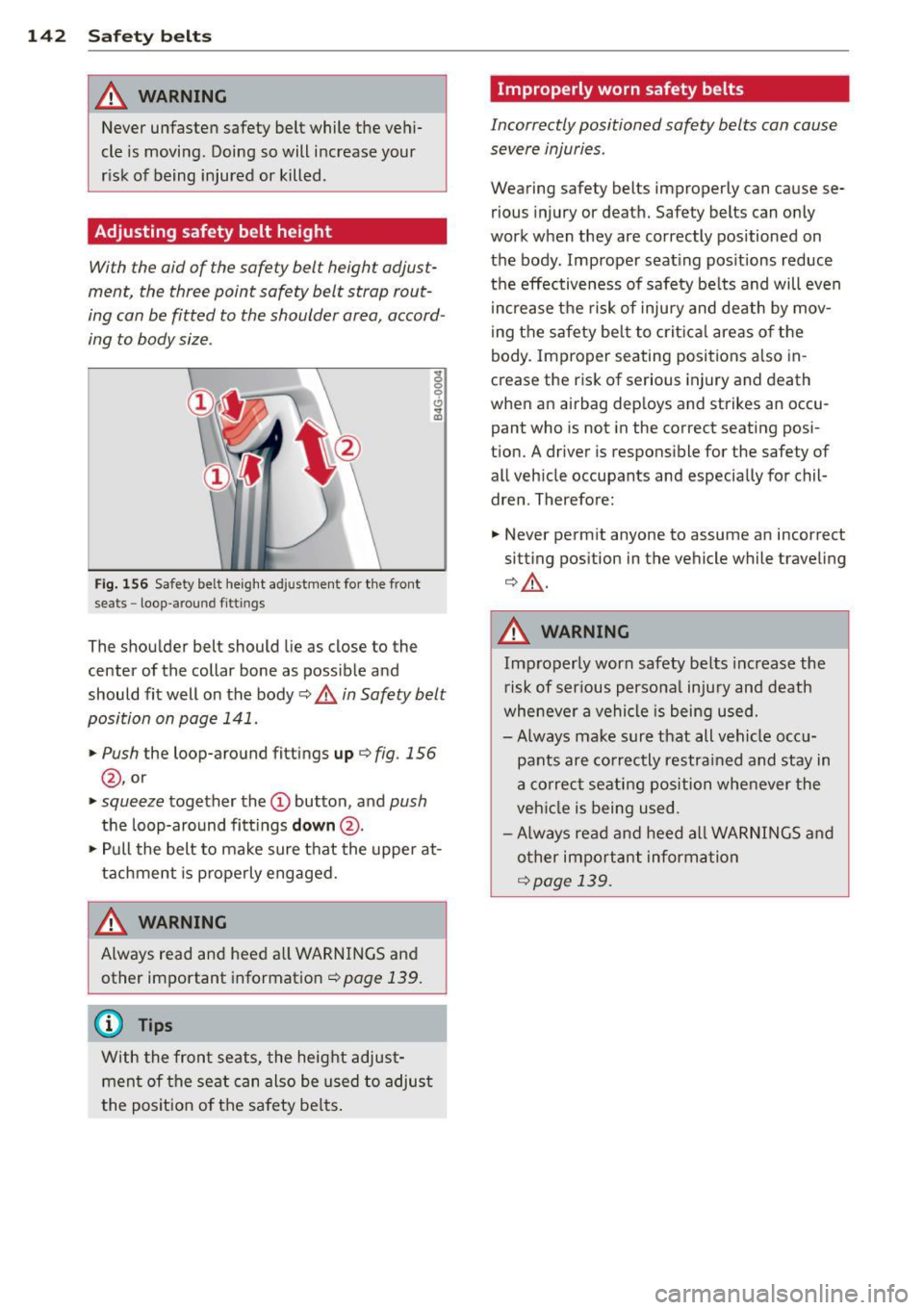
142 Safet y belt s
A WARNING
Never unfasten safety belt while the vehi
cle is moving. Doing so will increase your
r isk of being injured or killed .
Adjusting safety belt height
With the aid of the safety belt height adjust
ment, the three point safety belt strap rout
ing can be fitted to the shoulder area, accord
ing to body size .
Fig. 156 Safety belt height adjustment for the front
sea ts - loop -around f ittings
The shoulder belt should lie as close to the
center of the collar bone as possible and
should fit well on the body¢
A in Safety belt
position on page 141.
,. Push
the loop-aro und fittings up ¢fi g. 156
@ , or
"'"squeeze together the@ button, and push
the loop-around fitt ings down @.
"'" Pull the belt to make sure t hat the upper at
tachment is p roperly engaged.
A WARNING
Always read and heed a ll WARNINGS and
other important information¢
page 139 .
@ Tips
With the front seats, the height adjust
men t of the seat can also be used to adjus t
the posit ion of the safety be lts.
Improperly worn safety belts
Incorrectly positioned safety belts can cause
severe injuries .
Wearing safety belts improperly can cause se
rious injury or death. Safety belts can o nly
work when they are correctly positioned on
the body . Improper seat ing pos itions reduce
the effectiveness of safety belts and will even
i ncrease t he risk of inju ry and death by mov
ing the safety be lt to crit ica l areas o f the
body. Improper seating positions also in
crease the risk of serious injury and death
when an airbag deploys and strikes an occu
pant who is not in the correct seating posi
tion. A driver is respons ible for the safety of
all veh icle occupants and especially for chil
dren . Therefore:
"'" Never permit anyone to assume an incorrect
sitting position in the vehicle while traveling
¢&_ .
A WARNING
Improperly worn safety belts increase the
r isk of ser ious persona l injury and death
whenever a vehicle is being used.
- Always ma ke sure that all vehicle occ u
pants are co rrectly restra ined and stay in
a correc t seating position whe never the
veh icle is being used .
- Always read and heed all WAR NINGS and
o ther important inform ation
¢page 139.
Page 145 of 314
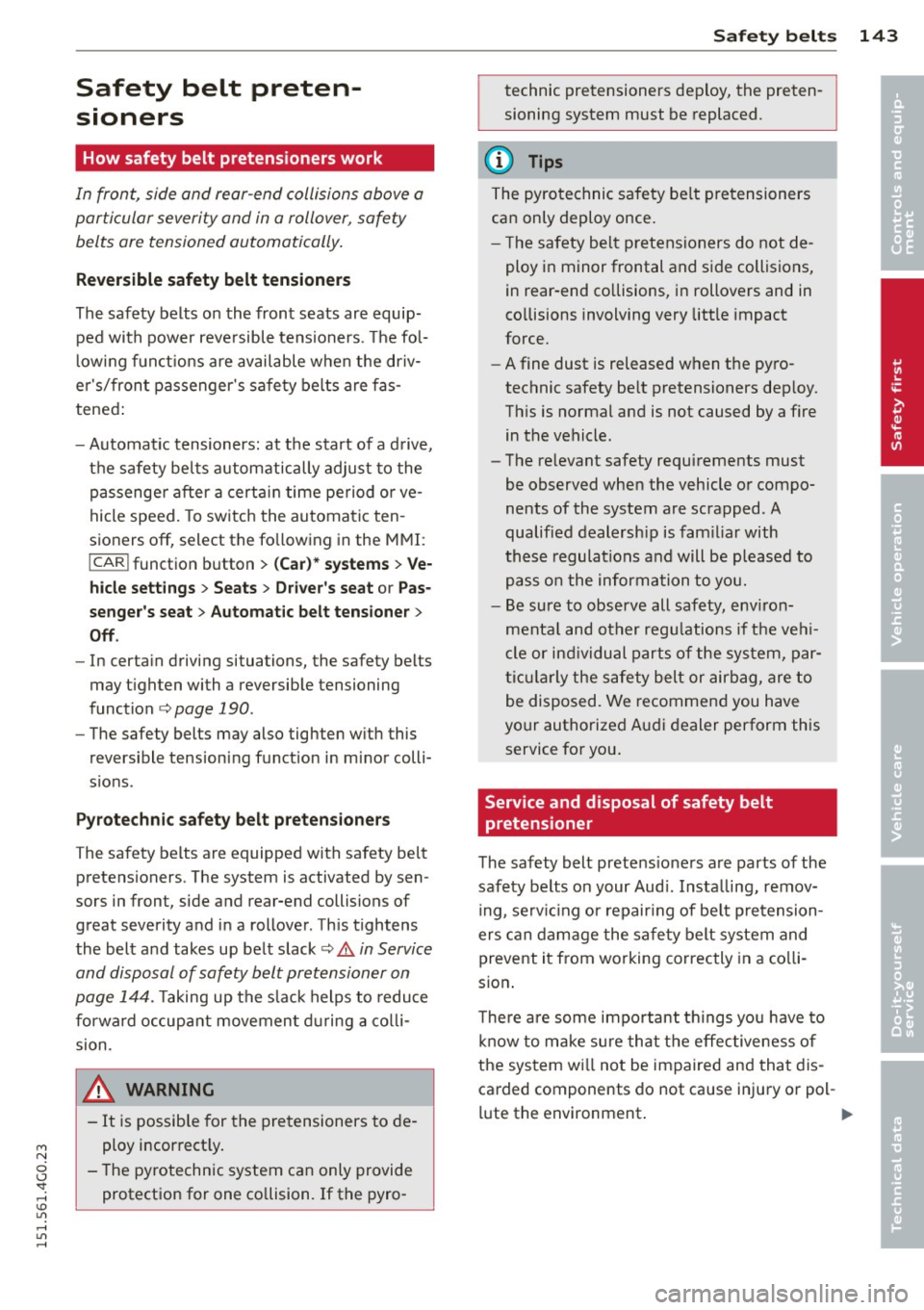
M N
0 <.J 'SI: ...... \!) ..,.,
...... ..,., ......
Safety belt preten
sioners
How safety belt pretensioners work
In fron t, side and rear-end collisions above a
parti cular severi ty and in a rollover, safety
b e lts ar e te nsion ed automatically .
Reversible safety belt tensioners
The safety belts on the front seats are equip
ped wit h power reve rsible tensioners . T he fo l
l ow ing f un ct ions are available w hen the dr iv
e r' s/fron t passenger 's sa fety bel ts are fas
tened :
- Automatic tensioners: at the start of a d rive,
the safety be lts automatically adjust to the
passenge r aft er a certai n time period o r ve
hicle speed. To switch the automa tic ten
s ioners off, select the fo llow ing in the M MI:
I CAR I funct ion button > (Car )* systems > Ve·
hide sett ings
> Seats > Driver 's seat or Pas
senger's seat
> Automat ic belt tensione r >
Off.
-In certa in driving situations, the safety belts
may t ighten with a reversib le tensioning
function
¢ page 190.
-The safety belts may also tighten w ith this
r evers ible tension ing funct ion in mino r colli
s ions .
Pyrotechnic safety belt pretensioners
The safety be lts are equipped with safety be lt
pretensioners. The system is activated by sen
s o rs in fron t, side and rear-end collisions of
great severity and in a rollover . Th is tightens
the bel t and takes up be lt slack ¢&.
in Service
and disposal of safety belt pre tensioner on
page 144.
T aking up the s lack helps to redu ce
forward occup ant movemen t during a colli
sion.
A WARNING
- It is possib le for the pre tensioners to de
ploy i ncor rect ly .
- T he pyrotechnic sys tem can only provide
protection for one co llision. If the pyro -
Safety belts 143
technic pretensioners deploy, the preten
sioning system must be replaced .
(D Tips
The pyro technic safety be lt pretensioners
ca n only deploy once .
- T he safety bel t pretensioners do not de
ploy in minor frontal and s ide collisions,
in rear-end co llisions, i n rollovers and in
co llisions involving very little impact
f o rce.
- A fine dust is released w hen the py ro
technic safety be lt pretensioners dep loy.
Th is is normal and is not caused by a fire
in the vehicle.
- The re levant safety requi rements must
be observed when the vehicle or compo
nents of the system are scrapped . A
qualified dealership is fam iliar with
these regulations and will be please d to
pa ss o n the information to yo u.
- Be sure to observe all safety, env iron
ment al and ot her regu la tio ns if t he ve hi
cle or ind ividu al p ar ts of t he system, par
t ic ular ly the s afe ty belt or airbag, are to
be disposed. We recommend you have
your authorized A udi dealer perform this
service fo r you .
Service and disposal of safety belt
pretensioner
The safety belt pretens ione rs are parts of the
saf ety be lts on your Aud i. Insta lling, remov
i ng, se rv ici ng o r repair ing of be lt pre tension
ers can dam age the safe ty belt sy stem and
prevent it from working correctly in a co lli
sio n.
T he re a re some impo rtan t thi ngs you have to
kn ow to m ake su re th at the effectiveness o f
t h e sys tem w ill not be impaired and tha t dis
ca rded components do not cause injury o r pol -
lu te the environment . ..,_ •
•
Page 150 of 314
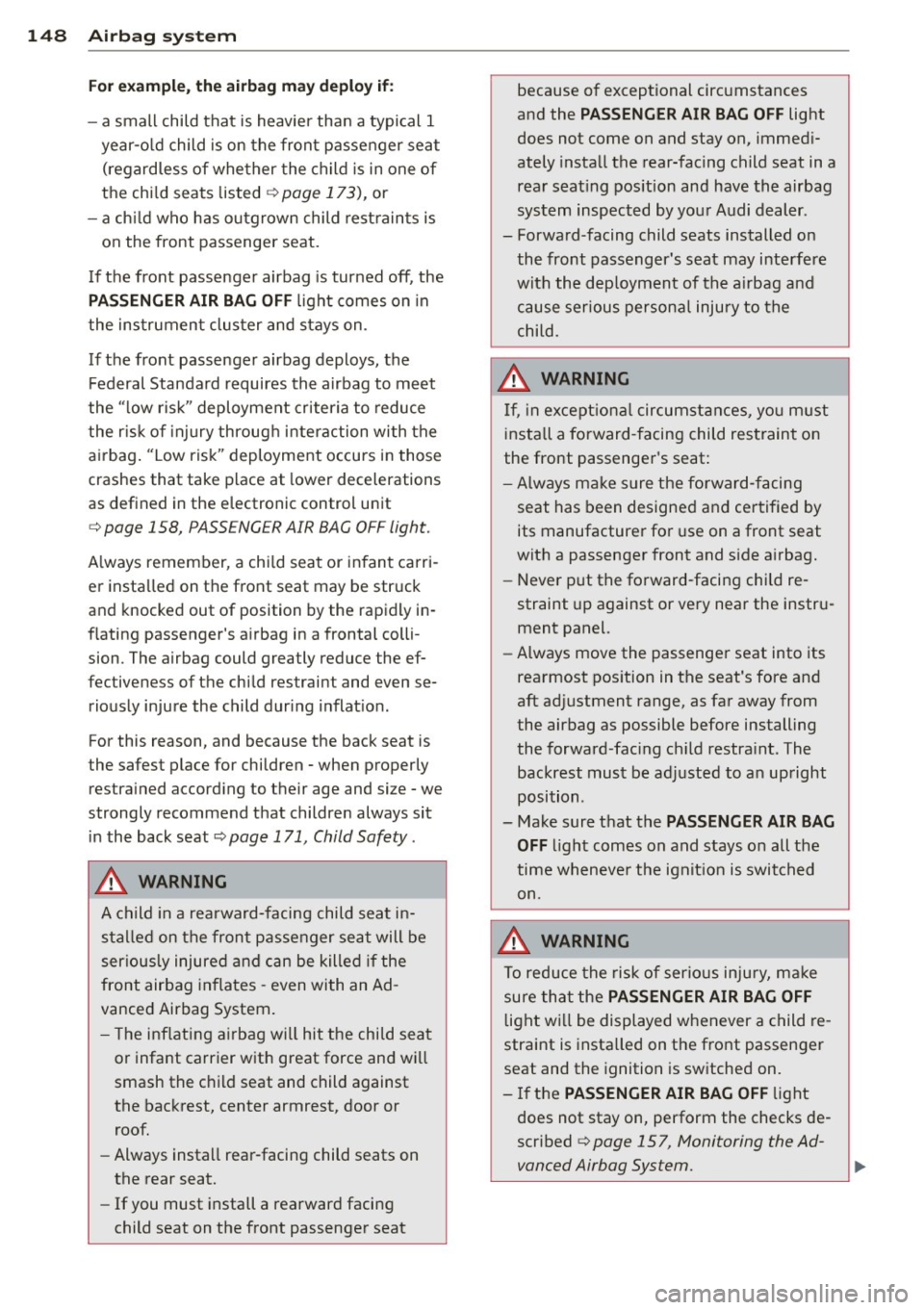
148 Airbag sys tem
For exa mple , the ai rb ag ma y depl oy if:
-a small child that is heavier than a typical 1
year-o ld child is on the front passenger seat
(regardless of whe ther the child is in one of
the chi ld seats listed
¢ page 173), or
- a ch ild who has outg rown child rest raints is
on the front passenger seat.
If the front passenger airbag is turned off, the
PA SSENGER AIR BAG OFF light comes on in
the ins trumen t cluster and stays on .
If the front passenger airbag deploys, the F ederal Standard requires the a irbag to meet
the "low risk" deployment criteria to reduce
the r isk o f injury through interaction with the
ai rbag . "Low risk" deployment occurs in those
crashes that take place at lower decelerations
as defined in the electronic control unit
¢ page 158, PASSENGER AIR BAG OFF light.
A lways remember, a chi ld seat or infant carri
er insta lled on t he front seat may be struck
and knocked out of position by the rapidly in
flating passenger's airbag in a frontal colli
sion. The airbag could greatly reduce the ef
fectiveness of the child restraint and even se
riously injure the child during inflat ion.
For this reason, and because the back seat is
the safest place for children - when properly
restra ined accord ing to their age and size - we
strongly recommend that children always sit
i n the back seat¢
page 171, Child Safety .
A WARNING
A child in a rearward-facing child seat in
stalled on the front passenger seat will be
ser iously injured and can be killed if the
front airbag inflates -even with an Ad
vanced Airbag System.
- T he inflating a irbag will hit the child seat
or infant carrier with great force and will
smash the child seat and child against
the backrest, center armrest, door or roof.
- Always insta ll rear-facing child seats on
the rear seat.
- If you must install a rearward facing
child seat on the front passenge r seat because of exceptional circumstances
and the
PASSENGER AIR BAG OFF light
does not come on and stay on, immed i
ately insta ll the rear-facing child seat in a
rea r seat ing pos ition and have the airbag
system inspected by you r Audi dealer.
- Forward-facing child seats installed on the front passenger's seat may interfere
with the dep loyment of the a irbag and
cause serious persona l injury to the
child.
A WARNING
If, i n except iona l circumstances, you m ust
i nsta ll a forward -facing child res traint on
the front passenge r's seat:
- Always make sure the forwar d-fa cing
seat has been designe d and cer tified by
its manufacture r for use on a front seat
with a passenger front and s ide a irbag.
- Never p ut the forward-facing child re
straint up against or very near the instru
ment panel.
- Always move the passenge r seat into its
rearmost pos ition in the seat's fore and
aft ad justment range, as fa r away from
the airbag as possible before installing the forward-fac ing ch ild restra int. The
backrest must be adj usted to an up right
position .
- Make sure that the
PASSENGER AIR BAG
OFF
li ght comes on and stays on all t he
time wheneve r the ignit ion is switched
on.
A WARNING
To reduce the risk of serious inju ry, m ake
sure that the
PASSENGER AIR BAG OFF
light w ill be displayed whenever a child re
straint is insta lled on the front passenger
seat and the ignition is switched on.
- If the
PASSENGER AIR BAG OFF light
does not stay on, perform the checks de
scribed
c> page 15 7, Monitoring the Ad-
vanced Airbag System. ..,.
Page 151 of 314
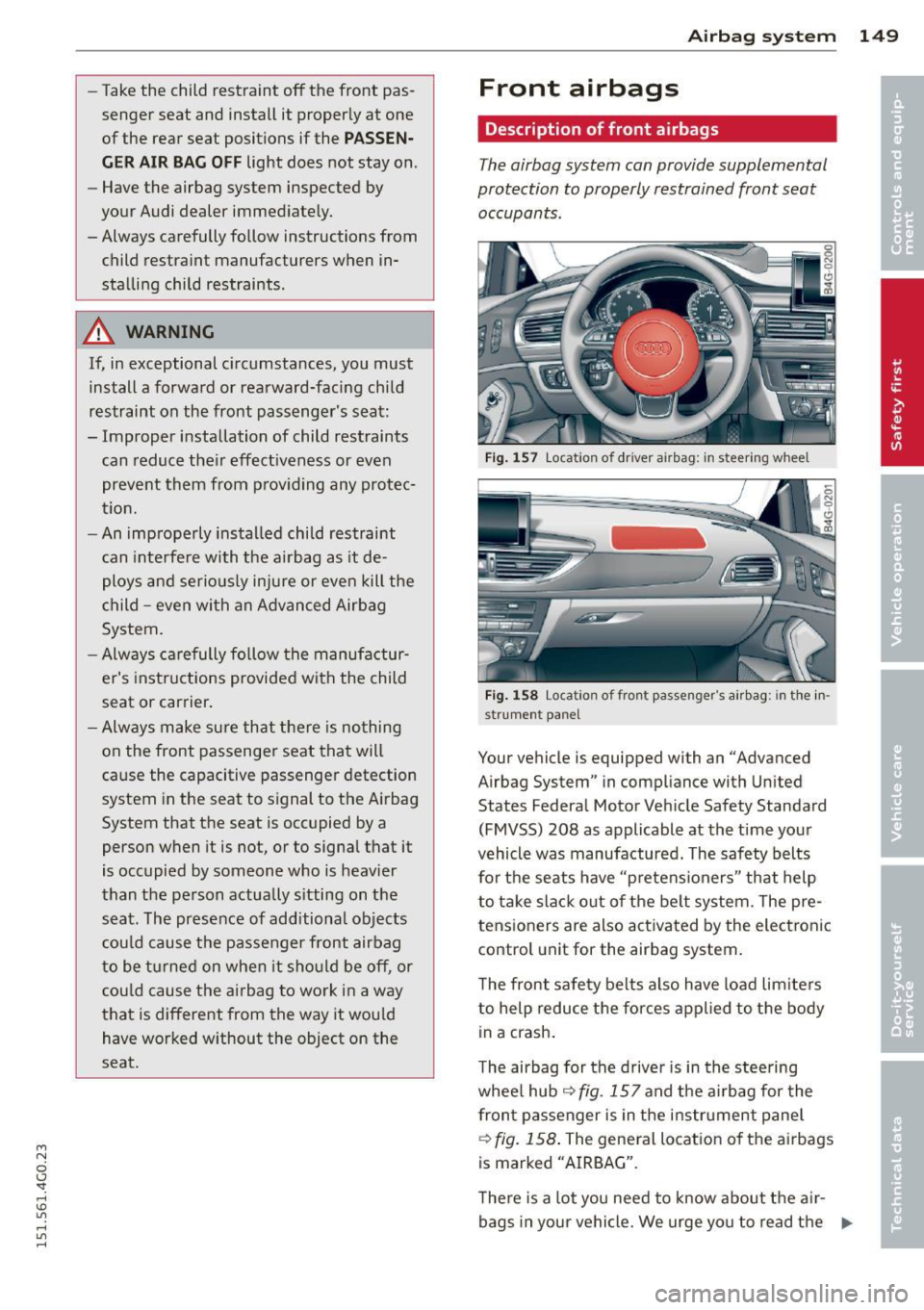
M N
0 I.J ""'. rl I.O
"' rl
"' rl
-Take the child restraint off the front pas
senger seat and install it properly at one
of the rear seat positions if the
PASSEN
GER AIR BAG OFF
light does not stay on .
- Have the airbag system inspected by
your Audi dealer immediately.
- Always carefully follow instructions from
child restraint manufacturers when in
stalling child restraints .
_& WARNING
If, in exceptional circumstances, you must
install a forward or rearward-facing child
restraint on the front passenger's seat:
- Improper installation of child restraints
can reduce their effectiveness or even
prevent them from providing any protec
tion.
- An improperly installed child restraint
can interfere with the airbag as it de
ploys and seriously injure or even kill the
child - even with an Advanced Airbag
System.
- Always carefully follow the manufactur
er's instructions provided with the child
seat or carrier.
- Always make sure that there is nothing
on the front passenger seat that will
cause the capacitive passenger detection
system in the seat to signal to the Airbag
System that the seat is occupied by a person when it is not, or to signal that it
is occupied by someone who is heavier
than the person actually sitting on the
seat . The presence of additional objects
could cause the passenger front airbag
to be turned on when it should be off, or
could cause the airbag to work in a way
that is different from the way it would have worked without the object on the
seat.
Airbag system 149
Front airbags
Description of front airbags
The airbag system can provide supplemen tal
protection to properly restrained front seat occupants.
Fig. 157 Locat io n of drive r airbag : in steering wheel
Fig. 158 Locat ion of fron t pa ssenger' s airbag: in the in·
st rument panel
Your vehicle is equipped with an "Advanced
Airbag System" in compliance with United
States Federal Motor Vehicle Safety Standard
(FMVSS) 208 as applicable at the time your
vehicle was manufactured. The safety belts
for the seats have "pretensioners " that help
to take slack out of the belt system. The pre
tensioners are also activated by the electronic
control unit for the airbag system.
The front safety belts also have load limiters
to help reduce the forces applied to the body
in a crash.
The airbag for the driver is in the steering
wheel hub
~ fig . 157 and the airbag for the
front passenger is in the instrument panel
¢ fig. 158. The general location of the airbags
is marked "AIRBAG".
There is a lot you need to know about the air
bags in your vehicle. We urge you to read the .,..
Page 153 of 314
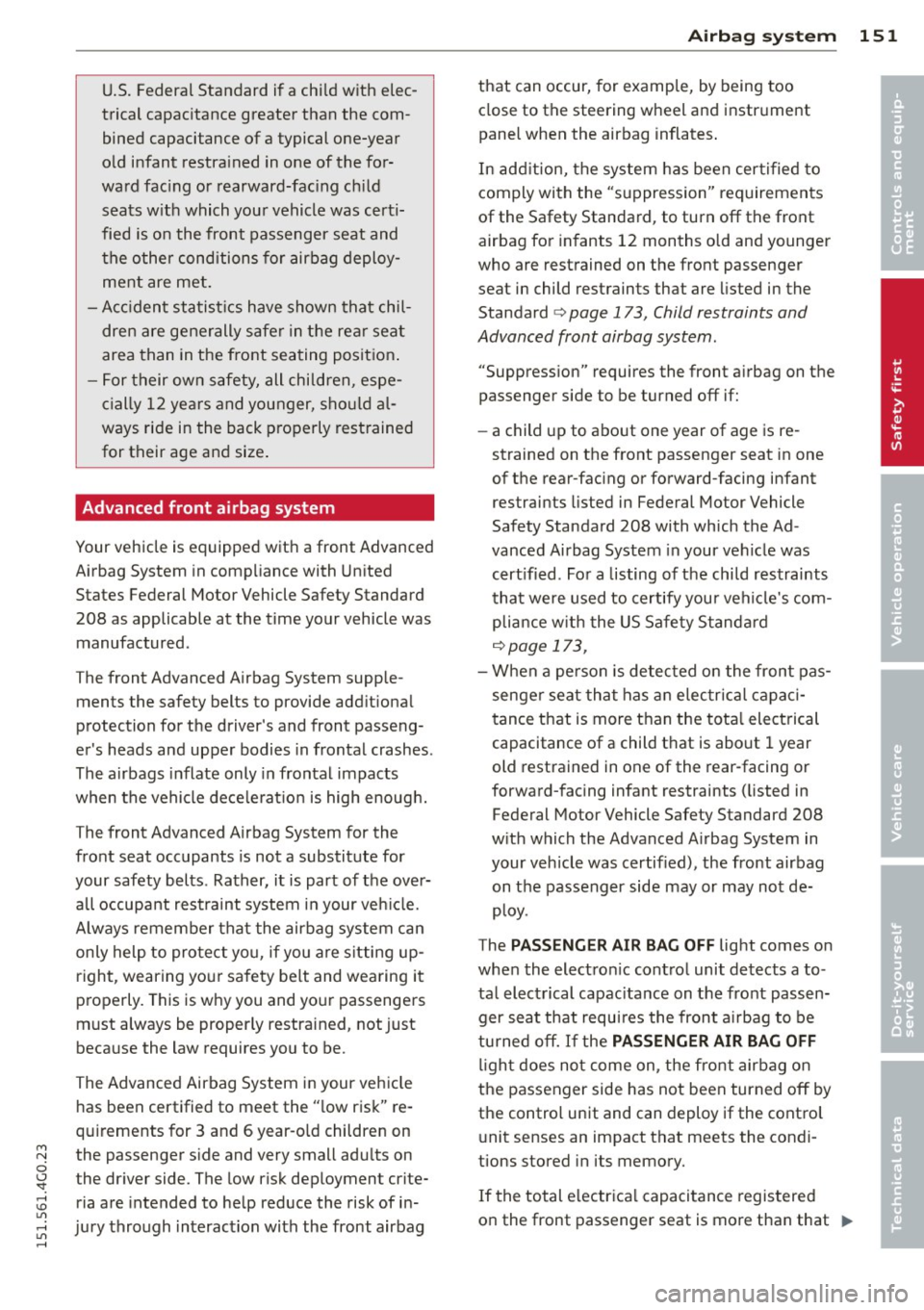
M N
0 <.J 'SI: ,...., \!) ..,.,
,...., ..,., ,....,
U.S. Federal Standard if a child with elec
trical capac itance greater than the com
bined capacitance of a typical one-year
old infant restrained in one of the for
ward fac ing or rearward-fac ing ch ild
seats w ith which your vehicle was certi
fied is on the front passenger seat and
the other conditions for airbag deploy ment are met.
- Acc ident statist ics have shown that chil
dren are generally safer in the rea r seat
area than in the front seating posit ion .
- For their own safety, all children, espe
cially 12 years and younger, sho uld al
ways ride in the back p roperly rest rained
for their age and size .
Advanced front airbag system
Your vehicle is equipped with a front Advanced
Airbag System in comp liance with Un ited
States Federal Motor Vehicle Safety Standard 208 as applicable at the time your vehicle was
manufactured.
The front Advanced Airbag System supple ments the safety belts to provide add it iona l
protection for the driver's and front passeng
e r's heads and upper bodies in frontal crashes.
The airbags inflate only in frontal impacts
when the vehicle dece le rat io n is high enough.
The front Advanced A irbag System for the
front seat occupants is not a substitute for
your safety belts . Rather, it is part of the over
all occupant rest raint system in your ve hicle.
A lways remember that the airbag system can
only help to pro tect you, if you are s itting up
righ t, wearing your sa fety belt and wearing it
properly. This is why you and yo ur passengers
must always be properly restrained, not just
because the law requires you to be.
The Advanced Airbag System in your vehicle h as been certified to meet the " low r isk" re
q ui rements for 3 and 6 year-o ld children on
the passenger s ide and very small adu lts on
the dr iver side. The low risk deployment crite
ria are intended to he lp reduce the risk of i n
j ury through interaction with the front airbag
A irbag system 15 1
that can occur, for examp le, by being too
close to the steering wheel and instr ument
panel when the airbag inflates .
In add ition, the system has been certified to
comply with the "s uppression" requirements
of the Safety Standard, to turn off the front
airbag for in fants 12 months o ld and younger
who are restrained on the front passenger
seat in child restraints that are listed in the
Standard
c> page 173, Child restraints and
Advanced front airbag system .
"Suppression" requires the front a irbag on the
passenger side to be turned off if:
- a child up to abo ut one year of age is re
strained on the front passenger seat in one
of the rear-fac ing or forward -facing infant
restraints listed in Federal Motor Vehicle
Safety Standard 208 with which the Ad
vanced Airbag System in your ve hicle was
cert ified . For a listing of the chi ld restraints
that were used to certify you r vehicle's com
p lia nce w it h t he US Safety Standa rd
c>page 173,
-When a pe rson is detec ted o n the front pas
senge r seat that has an e lec trica l capa ci
tance t hat is more than the tota l electrical
capacitance of a child that is about 1 year
old restrained in one of the rear-facing or
forward-facing infant restraints (listed in Federal Motor Vehicle Safety Standard 208
w ith which the Advanced A irbag System in
your vehicle was certified), the front airbag
on the passenger side may or may not de
ploy.
The
PASSENG ER AIR BAG OFF light comes on
when the electron ic cont ro l unit detects a to
ta l elect rical capac itance on the front passen
ger seat that requi res the front a irbag to be
turned off. If the
PAS SENGER AIR BAG OFF
light does no t come on, the front airbag on
the passenger side has not been turned off by
the contro l unit and can deploy if the control
u nit senses an impact that meets the condi
tions stored in its memory.
If the total e lectr ica l capacitance registered
on the front passenger seat is more than that
ll>
•
•
Page 154 of 314
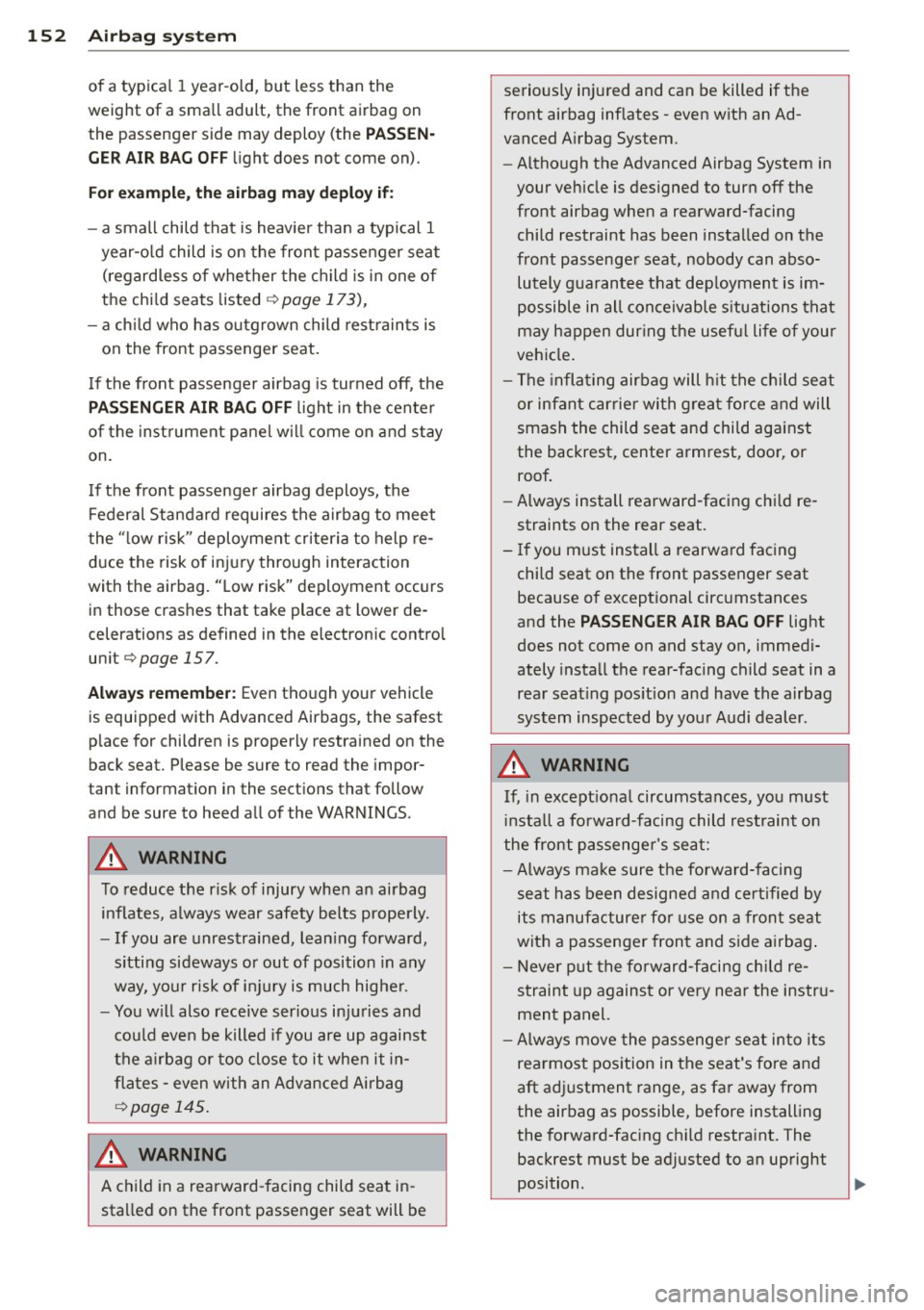
152 Airbag sys te m
of a typ ica l 1 year -old, but less than the
weight of a sma ll adult, the front airbag on
the passenger side may deploy (the
PASSEN
GER AIR BAG OFF
li ght does not come on).
For exa mple , the air bag m ay depl oy if:
- a small child that is heavier than a typical 1
year-o ld child is on the front p assenger seat
(regardless of whe ther the child is in one of
the chi ld seats listed
c':> page 173),
-a ch ild who has o utgrown child rest raints is
on the front passenger seat.
If the front passenger airbag is turned off, the
PA SSENGER AIR BAG OFF light in the cente r
of the instrument panel w ill come on and stay
on.
If the front passenger airbag deploys, the Federal Standard requires the a irbag to meet
the "low risk" deployment criteria to help re
duce the risk of injury through interaction
with the airbag. " Low risk" deployment occurs
in those crashes that take place at lower de
celerations as defined in the e lectronic control
un it
c':>page 157.
Alway s remember: Even tho ugh your vehicle
is equipped with Advanced Airbags, the safest
p lace for children is properly restrained on the
back seat. Please be sure to read the impor
tant information i n the sect ions that follow
and be sure to heed a ll of the WARNINGS .
A WARNING
To reduce the risk of injury when an airbag
inf lates, a lways wear safety belts prope rly.
- If you are unrestrained, lean ing forward,
sitting sideways or out of position in any
way, your risk of injury is much higher.
- You w ill also receive serious in juries and
cou ld even be killed if you are up against
the a irbag or too close to it when it in
fla tes -even with an Advanced Airbag
c':> page 145.
A WARNING
A child in a rearward -facing child seat in
stalled on the front passenger seat will be seriously injured and can be killed if the
front airbag inflates - even w
ith an Ad
vanced Airbag System.
- Altho ugh the Advanced Airbag System in
your veh icle is designed to turn off the
front airbag when a rearward-facing
child restraint has been installed on the
front passenge r seat, nobody can abso
lutely guarantee that dep loyment is im
possible in all con ceivable s ituations that
may h appen dur ing the usefu l life of y our
veh icle .
- T he inflating airbag will h it the ch ild seat
or infant carrier wi th grea t force and will
smash the child seat an d child against
the backrest, center armrest, doo r, or
roof.
- Always install rearward-facing chi ld re
straints on the rear seat.
- If you must install a rearward fac ing
child seat on the front passenger seat
because of exceptional circumstances
and the
PASSENGER AIR BAG OFF light
does not come on and stay on, immed i
ately insta ll the rear-facing child seat in a
rea r seat ing pos ition and have the airbag
system inspected by you r Audi dealer.
A WARNING
If, in except iona l circumstances, you must
i nsta ll a forward-facing child restraint on
the front passenge r's sea t:
- Always make sure the forward-facing
seat has been designed and ce rtified by
its manufacture r fo r u se on a fron t seat
with a passenger fron t and s ide a irbag .
- Never p ut the fo rward-facing child re
straint up agains t or ve ry near the instru
ment panel.
- Always move the p assenge r seat into its
rearmost pos ition in the seat's fore and
aft ad justment range, as fa r away from
the airbag as possible, before installing
the forward-facing ch ild restra int. The
backrest must be ad justed to an upright
position.
Page 156 of 314
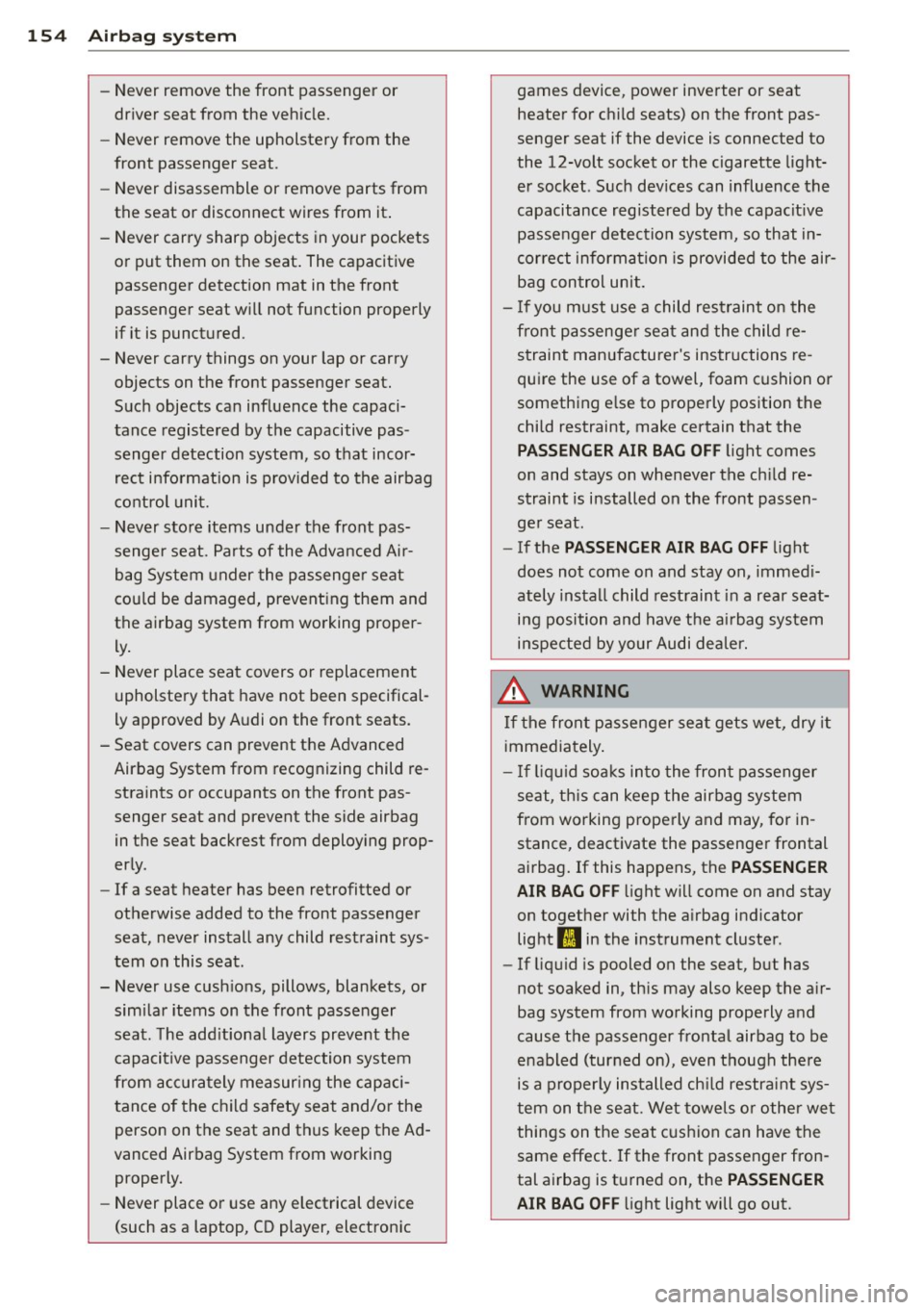
154 Airbag system
-Never remove the front passenger or
driver seat from the vehicle.
- Never remove the upholstery from the
front passenger seat.
- Never disassemble or remove parts from
the seat or disconnect wires from it.
- Never carry sharp objects in your pockets
or put them on the seat. The capacitive
passenger detection mat in the front
passenger seat will not function properly
if it is punctured .
- Never carry things on your lap or carry objects on the front passenger seat.
Such objects can influence the capaci
tance registered by the capacitive pas
senger detection system, so that incor
rect information is provided to the airbag
control unit.
- Never store items under the front pas
senger seat. Parts of the Advanced Air
bag System under the passenger seat
could be damaged, preventing them and
the airbag system from working proper
ly.
- Never place seat covers or replacement upholstery that have not been specifical
ly approved by Audi on the front seats.
- Seat covers can prevent the Advanced Airbag System from recognizing child re
straints or occupants on the front pas
senger seat and prevent the side airbag
in the seat backrest from deploying prop
erly.
- If a seat heater has been retrofitted or
otherwise added to the front passenger
seat, never install any child restraint sys
tem on this seat .
- Never use cushions, pillows, blankets, or similar items on the front passenger
seat. The additional layers prevent the
capacitive passenger detection system
from accurately measuring the capaci
tance of the child safety seat and/or the
person on the seat and thus keep the Ad
vanced Airbag System from working properly.
- Never place or use any electrical device
(such as a laptop, CD player, electronic games device
, power inverter or seat
heater for child seats) on the front pas
senger seat if the device is connected to
the 12-volt socket or the cigarette light
er socket . Such devices can influence the
capacitance registered by the capacitive passenger detection system, so that in
correct information is provided to the air
bag control unit.
- If you must use a child restraint on the
front passenger seat and the child re
straint manufacturer's instructions re
quire the use of a towel, foam cushion or
something else to properly position the
child restraint, make certain that the
PASSENGER AIR BAG OFF light comes
on and stays on whenever the child re
straint is installed on the front passen
ger seat.
- If the
PASSENGER AIR BAG OFF light
does not come on and stay on, immedi
ately install child restraint in a rear seat
ing position and have the airbag system inspected by your Audi dealer.
,8. WARNING
If the front passenger seat gets wet, dry it
immediately.
- If liquid soaks into the front passenger
seat, this can keep the airbag system
from working properly and may, for in
stance, deactivate the passenger frontal
airbag. If this happens, the
PASSENGER
AIR BAG OFF
light will come on and stay
on together with the airbag indicator light
fl in the instrument cluster .
- If liquid is pooled on the seat, but has
not soaked in, this may also keep the air
bag system from working properly and
cause the passenger frontal airbag to be
enabled (turned on), even though there is a properly installed child restraint sys
tem on the seat . Wet towels or other wet
things on the seat cushion can have the
same effect. If the front passenger fron
tal airbag is turned on, the
PASSENGER
AIR BAG OFF
light light will go out.
Page 157 of 314
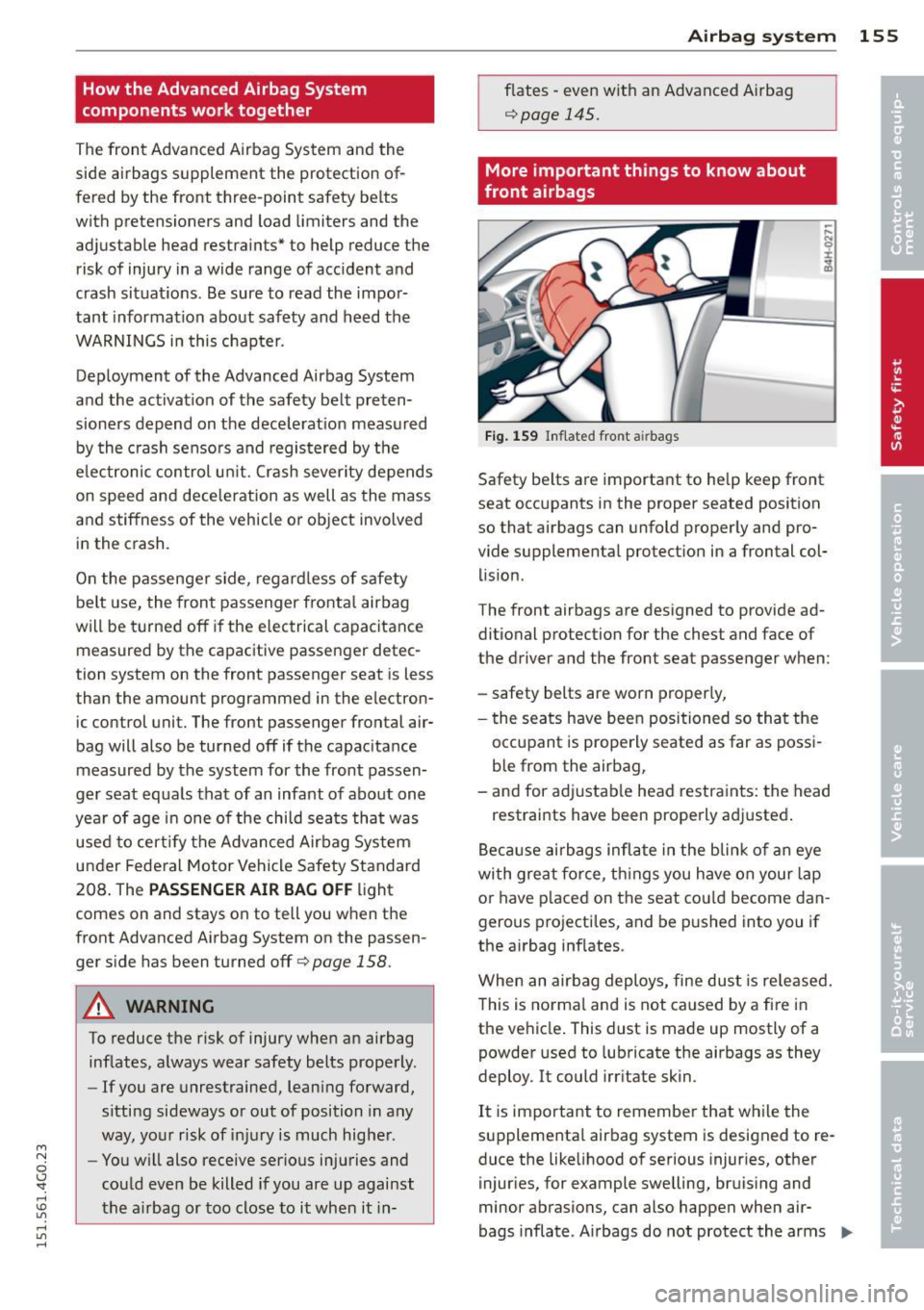
M N
0 I.J "". rl I.O
"' rl
"' rl
How the Advanced Airbag System
components work together
The front Advanced Airbag System and the
side airbags supplement the protection of
fered by the front three -point safety be lts
with pretensioners and load limiters and the
adjustable head restra ints* to help reduce the
risk of injury in a wide range of acc ident and
crash situat ions. Be sure to read the impor
tant information about safety and heed the
WARNINGS i n this chap ter.
Dep loyment of the Advanced Airbag System
and the activat ion of the safety be lt pre ten
sioners depend on the dece lerat ion meas ured
by the c rash senso rs and registered by the
e lectronic control u nit. Cr ash severity depends
on speed and dece leration as well as the mass
and stiffness of the vehicle or object involved
in the crash.
On the passenge r side, reg ard less of safety
be lt use, the fron t passenger fronta l airbag
will be t urned off i f the electrical capacitance
measured by the capac itive passenger detec
tion system on the front passenger seat is less
than the amount programmed in the e lectron
ic control unit. The front passenger frontal air
bag will also be turned off if the capac itance
measured by the system for the front passen
ge r seat equa ls that of an infant of about one
year of age in one of the child seats that was
used to cert ify the Advanced Airbag Sys tem
u nder Fede ral Motor Vehicle Safety Standard
208 . The
PASSENGER AIR BAG OFF light
comes on and stays on to tell you when t he
front Advanced Airbag System on the passen
ger s ide has been turned off¢
page 158.
A WARNING
To reduce the risk of injury when an airbag
inf lates, a lways wear safety belts properly.
- If you are unrestrained, lean ing forward,
sitting sideways or out of position in any
way, yo ur r isk of inj ury is much hig he r.
- You w ill also receive serious injuries and
cou ld eve n be killed if you are up against
the a irbag or too close to it when it in-
A irba g sy stem 155
flates -even w it h an Advanced A irbag
¢page 145.
More important things to know about
front airbags
Fi g. 1 59 In flated front airbags
Safety be lts are important to he lp keep front
seat occupants in the proper seated position
so that airbags can unfold properly and pro
vide supplementa l protect ion in a frontal col
li s ion.
The front airbags are des igned to provide ad
ditional protection for the chest and face of
the driver and the front seat passenger when:
- safety belts are worn proper ly,
- t he seats have been positioned so that the
occupant is properly seated as far as poss i
ble from the airbag,
- and for ad justab le head restra ints: the head
restraints have been properly adj usted .
Bec ause airbags infl ate in the bli nk of an eye
wi th great force, th ings you have on your lap
o r have p laced on the seat co uld become dan
gerous projectiles, and be p ushed into you if
the a irbag inf lates.
When an airbag deploys, fine dust is re le ased.
This is norma l and is not caused by a fi re in
the ve hicle . This dust is made up mostly of a
powder used to lubricate the airbags as they
deploy. It could irr itate skin.
It is important to remembe r that wh ile the
supplementa l airbag system is designed to re
duce the like lihood of serious injur ies, other
i njur ies, for example swelling, bruis ing and
minor abrasions, can also happen when air-
bags inflate. A irbags do not protect the arms .,_